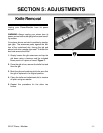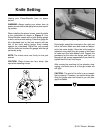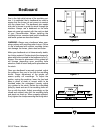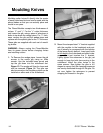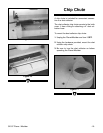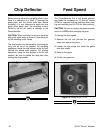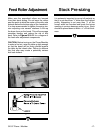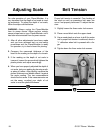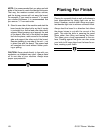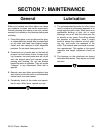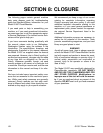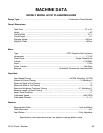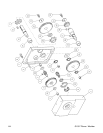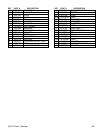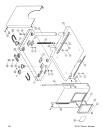
G1037 Planer / Moulder -19-
SECTION 6: OPERATIONS
Before you test your Planer/Moulder give it a
quick inspection.
1. Are all fasteners tight?
2. Are the mounting bolts secured to the
machine table top?
3. Is the Planer/Moulder oriented properly for
the type of job you will do?
4. Are each of the lock handles tightened
securely?
Once assembly is complete and adjustments are
done to your satisfaction, you are ready to test
the machine.
Turn on the power supply at the main panel.
Press the START button. Make sure that your fin-
ger is poised on the STOP button, just in case
there’s a problem. The Planer/Moulder should
run smoothly, with little or no vibration or rubbing
noises. Strange or unnatural noises should be
investigated and corrected before operating the
machine further.
WARNING: DO NOT attempt to investigate or
adjust the machine while it is running. Wait until
the machine is turned off, unplugged and all
working parts have come to a rest before you do
anything!
If noises occur that cannot be found by visual
inspection, feel free to contact our service depart-
ment for help.
Test Run
Thickness Planing
Thickness planing is the sizing of material to a
desired thickness, while creating a smooth sur-
face parallel to the opposite side of the board.
The art of thickness planing consists mainly of
using good judgement about the depth of cut in
various situations. You must take into account not
only the width of the stock, but hardness of the
board, its moisture content, grain direction and
grain structure.
The effects of these factors upon the quality of
the finished work can only be learned through
experience. It is always advisable, whenever
working with a new type of wood, or one with
unusual problems, to make test cuts on scrap
material if possible prior to working on your fin-
ished piece.
To properly use your Planer/Moulder for thick-
ness planing:
1. Measure the thickest part of the board to be
planed. Turn the table raising hand lever until
the scale depth of cut reads the thickness of
the board to be planed. Each full turn of the
lever raises the bed just over
1
⁄16''.
2. On boards less than 5'' wide, never plane
more than
1
⁄8'' at one time. On wider boards,
do not exceed
1
⁄
16'' depth of cut. If the differ-
ence between the board thickness and your
desired finished thickness exceeds
1
⁄8'', you
must make several passes, taking off
1
⁄
8'' or
less with each pass until the desired thickness
has been reached.



